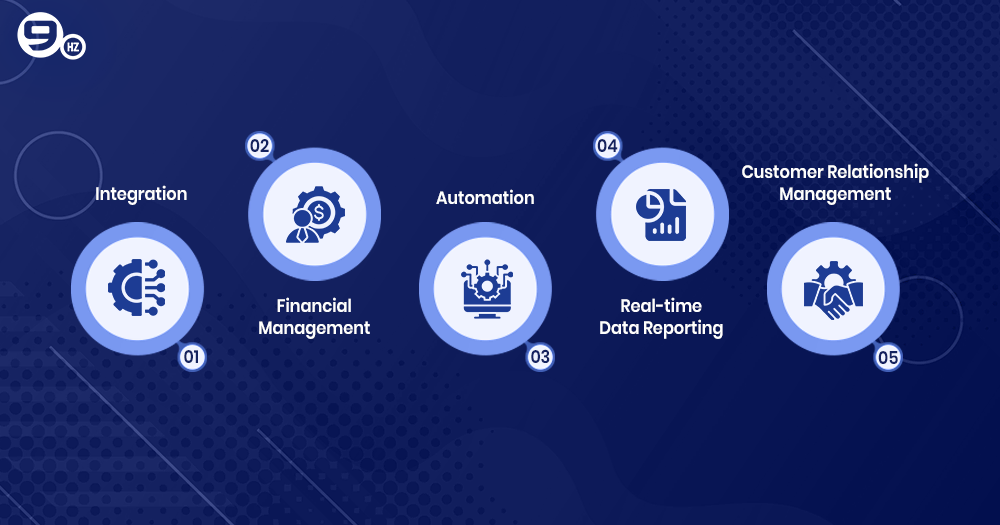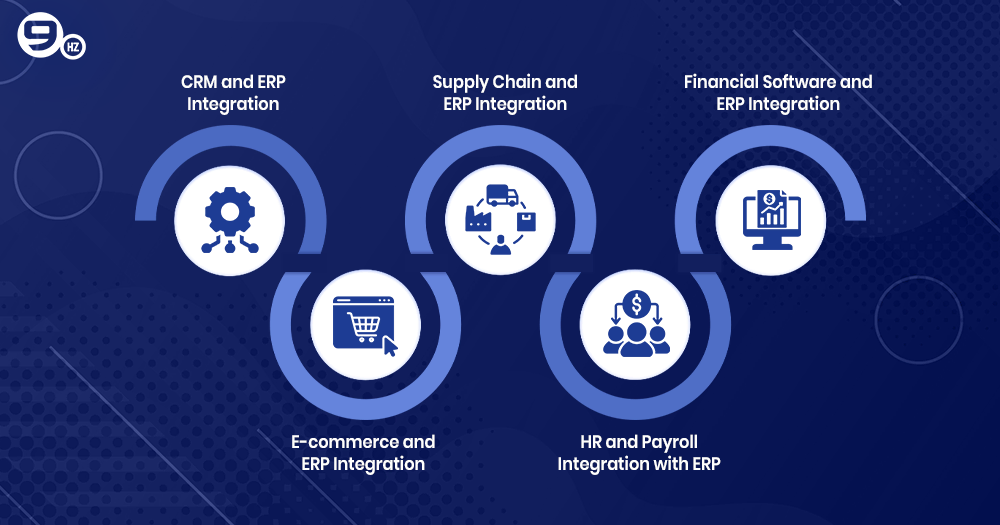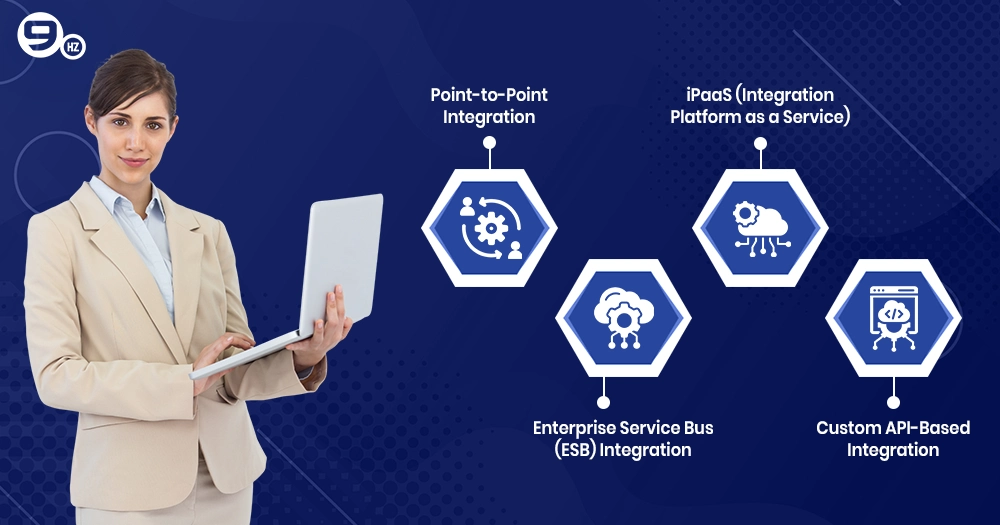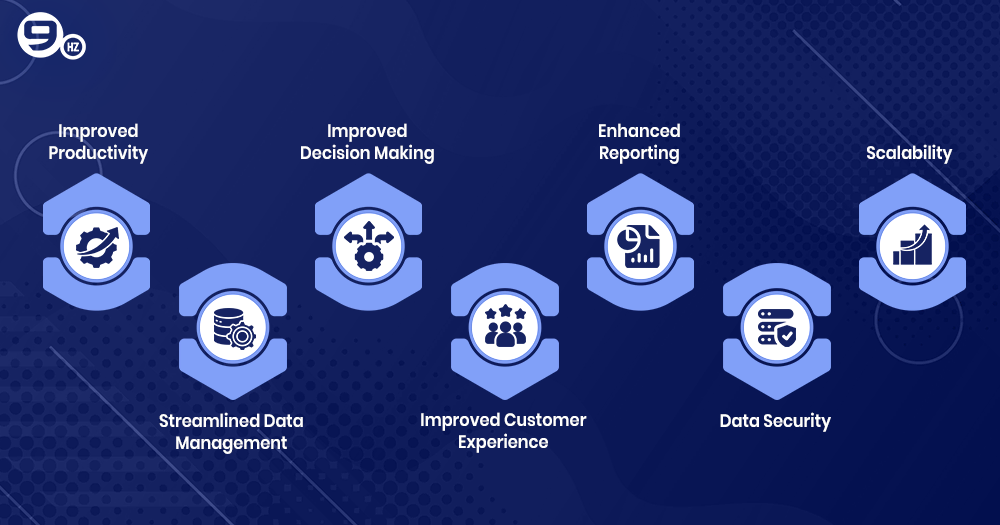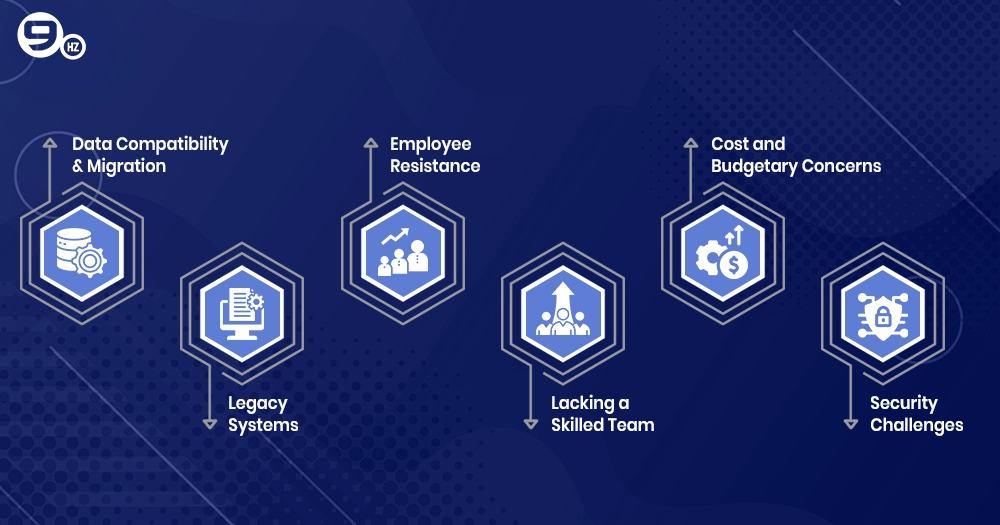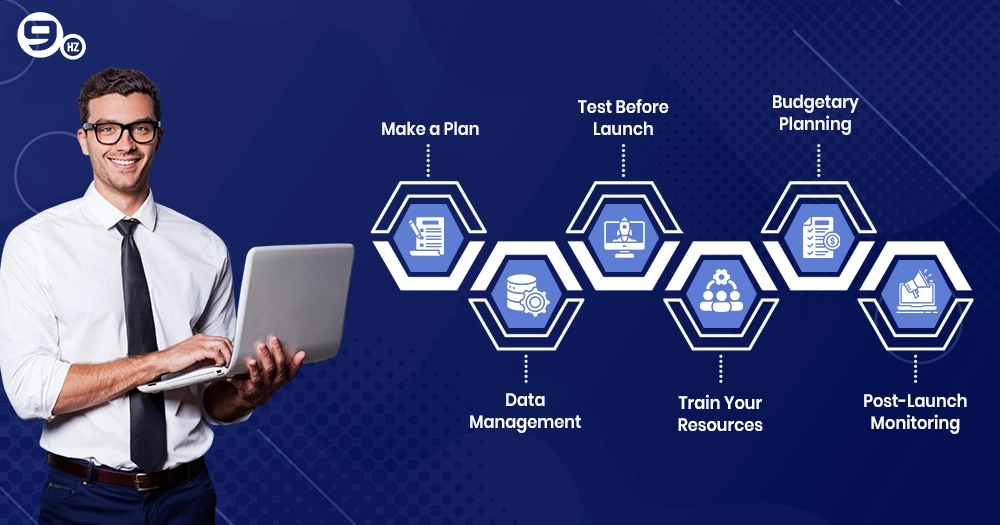Did you know the secret behind Cadbury?
Surprise—it’s not just about the chocolates. It’s their seamless supply chain and manufacturing operations powered by SAP ERP.
Interested to know about more brands leveraging ERP software integration – Right? Some other top examples are Amazon (SAP ERP), Starbucks (Oracle ERP), and Toyota (Microsoft Dynamics).
The ERP market is projected to be $97.3 billion by 2032 at a CAGR of 7.1% (2024–2034), and North America is the most dominant region, with 36% of the revenue share. The US ERP market is expected to grow to $28.39 billion by 2034.
Almost all large-scale organizations are adopting an ERP system into their practices. With the growing demand, ERP software development services are playing a key role in helping businesses build tailored systems that align with their operational needs. If you are also looking to learn more about it, here we’ve researched and compiled an article for you. This article will walk you through all the crucial details about ERP, its features and types, how to integrate it, and more before you start with ERP.
Let’s continue with the blog!
What is Enterprise Resource Planning Software?
The term ERP stands for Enterprise Resource Planning, which is a software system. Simplifying ERP, it acts as the central nervous system of an enterprise, seamlessly managing vital processes and operations by integrating them into a unified framework.
Integrating business data and processes, ERP helps enhance the quality of business operations, improve decision-making, and enable diverse functions such as HR, finance, manufacturing, supply chain, sales and marketing, project management, and more.
Another functionality is centralizing data management, connecting all processes, improving efficiency, and reducing errors and costs. Providing multiple benefits, ERP is now an inevitable software for companies and businesses looking for future growth.
To make all this possible, ERP software development is essential for building customized solutions tailored to specific organizational needs, ensuring that each module works in sync for maximum effectiveness. ERP software integration is the process of synchronizing and connecting ERP software to other systems or software in your organization, automating routine operations, and enhancing productivity.
Why is ERP Software Integration Important for Businesses?
ERP integration is essential for businesses as core and routine processes become complex with business expansion. The sole purpose is to provide 360-degree flexibility to a business, allowing it to track and streamline all processes and routine tasks.
Here are the top reasons to choose enterprise resource planning software integration:
1. Integrate Local/Global Data and Workflows
A perfect ERP system enables a company to centralize local and global data. With an overview of all data, you’ll have a clear view of location-specific data coordinating sales, manufacturing, inventory management, and distribution.
2. Cost Management with ERP Systems
One of the most notable benefits of ERP software integration is greater visibility into your company’s finances. As a real-life example, manufacturers can access a variety of data seamlessly, such as raw material cost, production cost, and selling cost, including other expenses.
3. Conquer Global Barriers
ERP systems help global businesses overcome currency and language barriers by converting financial data into local languages and currencies, enabling regional managers to view data at their own convenience.
4. Improved Collaboration
ERP eliminated data silos by centralizing data from all processes. It means that all teams can access updated, accurate, and consolidated information and make coordinated decisions based on it.
5. Enhancing Communication
ERP Software integration enhances team communication by providing linked data and processes that offer valuable context. Teams access information fast when order problems occur, and shared understanding helps teams collaborate on solutions.
Features of ERP Software
Now that we’ve explored the importance of ERP software integration, the next logical step is to examine its key features to understand them better.
1. Integration
An ERP system unified business processes, reducing errors and data silos, allowing seamless data transfer across departments, ensuring accurate and updated information for all teams.
2. Financial Management
ERP systems are essential tools for financial management, enabling finance teams to track and analyze critical business data and ensuring sound decision-making.
3. Automation
ERP automates all repetitive tasks, empowering a business to save time and money. Examples include manual data entry, inventory tracking, reporting, and more.
4. Real-time Data Reporting
Data-driven decision-making ability is necessary for a business’s success, and Custom ERP systems are designed to support this. They provide an intuitive dashboard and analytics for actionable insights. Additionally, you can create customizable reports to tailor your efforts for specific needs.
5. Customer Relationship Management
ERP and CRM are different. ERP integrates business functions, while CRM helps manage interactions. Modern ERP systems often integrate with CRM functionalities, enabling businesses to synchronize customer information like contact details, purchase history, and communication logs.
How Does the ERP System Work?
An ERP system centralizes business processes. Different departments utilize this system, such as sales, which enter customer orders; inventory, which tracks product levels; manufacturing, which plans production schedules; and finance, which manages accounting tasks.
In the context of work, all departments share a single database. Let’s understand through an example-
If a sale is entered, inventory updates automatically; on the other hand, the manufacturing department is notified about the new demand, and the finance department records a new transaction.
The ERP system integrates processes and information flows across all departments through smooth connections. This flow enables everyone from management to employees to view the same data. They can all make informed decisions in collaboration to operate the business efficiently.
What are the Different Types of ERP Systems?
Enterprise resource planning software integration is beneficial. But if you are looking for where to start, then the fact is this software comes in different types and is built for a purpose. You can choose the software that aligns with your needs. So, here are the key types of ERP systems as follows:
CRM and ERP Integration
CRM and ERP systems help businesses manage data. CRM handles customer data. ERP manages internal processes like inventory and finances. When you integrate CRM with ERP, your teams can share information easily. Sales and support teams can access inventory and billing details without switching systems. This makes their work faster and simpler.
E-commerce and ERP Integration
E-commerce platforms and ERP systems can work well together. ERP systems help you manage inventory, orders, and shipping. When you link them with your online store, everything stays updated. Customers see what’s in stock. Orders go directly to your ERP system. This cuts down on mistakes and saves time.
Supply Chain and ERP Integration
Supply chains have many steps. There’s planning, sourcing, making, and shipping. ERP systems help you track each step. Connecting your ERP with supply chain software lets you see everything in one place. This enables you to avoid delays and keep track of products easily.
HR and Payroll Integration with ERP
HR and payroll tasks can be complex. You need to handle employee records, salaries, and benefits. When you link HR and payroll systems to ERP, you simplify the process. It helps you avoid errors and saves time. Everything stays updated, from attendance to payroll reports.
Financial Software and ERP Integration
Managing finances needs accuracy. Financial software handles accounts, budgets, and reports. When you integrate it with ERP, you get real-time data. This makes reporting more straightforward. It also helps you track expenses and profits without double-entry.
Methods of ERP Software Integration
Before we know the methods, it is essential to have an overview of ERP Software integration. Therefore, ERP software integration is the process of connecting ERP software with day-to-day processes and applications to have crucial insights into the organization’s data, enhance data security, identify and remove data silos, and business process automation.
Let’s look at the types!
Point-to-Point Integration
Connecting two systems with customized code is called point-to-point ERP integration. The best part is that it addresses specific business needs and provides complete control over the integration. This method allows companies to have tailored integration, but it requires more cost and effort. Some other limitations also exist, such as its maintenance being time-consuming, not allowing for end-to-end process automation, and others.
Enterprise Service Bus (ESB) Integration
ESB acts as a middle layer between systems. It lets different software or applications talk to each other without direct links via the middle layer. This makes ERP Software Integration Services more flexible. You can add or remove systems without much trouble. Reducing dependencies, centralized tracking, and connecting legacy systems are its advantages. The limitations are limited support for connecting cloud applications and require expertise.
iPaaS (Integration Platform as a Service)
iPaaS offers cloud-based tools for ERP system integration. It’s useful when you need to connect cloud apps with on-site systems. It also helps with data management and monitoring. In simple terms, it is a third-party cloud-based platform that integrates with apps and on-premise systems. Its benefits are easy maintenance, critical data protection, and affordability. However, the process is time-consuming and requires a certain level of expertise.
For the best results, it would be best to seek the help of an ERP software development company with similar expertise.
Custom API-Based Integration
If you are looking for improved collaboration, streamlined operations, and cost-efficiency, custom API-based ERP integration is the right choice.This method uses APIs to connect systems and gives you control over how data moves. The notable benefit is that it is highly customizable and aligns with specific business needs, but it requires appropriate development resources.
Key Benefits of ERP Software Integration
The idea of an ERP system is simple: bring all departments and their information together in one cohesive platform. However, the advantages it offers are extensive. So, here are some top benefits of ERP system integration.
Improved Productivity
ERP systems help businesses save time by automating routine and arduous tasks such as data entry, order processing, procurement needs, inventory management, fulfillment processes, and more. They also improve the productivity of departments, teams, and organizations.
Streamlined Data Management
ERP combines data from all sources into a single place, making ERP software integration advantageous. It ensures that all teams work with accurate and up-to-date information, preventing duplication and manual work.
Improved Decision Making
With access to real-time data, you can make quick, informed decisions. Having all the departments access the same information makes trend analysis and forward planning more straightforward.
Improved Customer Experience
ERP Custom integration provides customer support teams with access to real-time inventory and billing information. This enhances overall service quality and accelerates speed and responses.
Enhanced Reporting
Reporting helps track and monitor business and operational performance. An Integrated ERP system offers cutting-edge reporting tools. Using it, you’ll be able to produce timely reports for monitoring performance and finding areas for improvement.
Data Security
Custom ERP integration offers your data in one secure, centralized system. This enables you to apply security policies to block unauthorized access easily.
Scalability
Enterprise resource planning software integration also supports businesses for scalability. As your business grows, Custom ERP integration simplifies adding new systems and procedures. This adaptability allows you to remain competitive and respond to evolving needs.
How to Know if Your Organization is Ready for the ERP System Integration?
Surprisingly, 95% of companies admitted that their processes improved after ERP implementation, and 74% of companies experienced enhanced productivity. That is enough to prove how ERP integration is essential for an organization.
If you also want to know whether your organization is ready to integrate an enterprise resource planning system, consider the following:
Frequent Data Errors
If your company is witnessing inconsistent and redundant data across systems, and whatever data you have is tending towards accuracy and creating issues for data collaboration, it is the right time for ERP integration.
Time Consuming Routine Operations
If your day-to-day operations are more time-consuming than they were in their previous state or when you started. It indicates you need an ERP software for routine operations automation to save time and resources.
Disconnected Systems
When existing tools fail to work together seamlessly, delays and errors can occur. ERP system integration addresses these gaps to enhance coordination and overall efficiency.
Scattered Data
If you are experiencing difficulty accessing critical business data that is scattered, ERP will help you make it available in a single place. After integrating ERP software, you can access it smoothly.
Incompatible Software Tools
Before planning for integration, assess your existing software tools. If these create confusion and fail to share information in real time, it is time to use an enterprise resource planning(ERP) system for a clearer view.
Workflow Bottlenecks
Seamless workflows lead a business to the desired and excellent results. Assess your workflows to identify all bottlenecks. If they lack coordination and performance is slow, your company is ready to adopt ERP.
Challenges in ERP Software Integration
Although ERP integration is promising, it also has challenges, such as data migration and legacy systems. Let’s review the associated challenges.
Data Compatibility & Migration
Seamless data flow across departments and modules is a prime need for every ERP system. However, if data does not have a uniform structure and random naming conventions, it can create issues for ERP software integration.
Legacy Systems
Ignorance of adopting new technologies creates numerous problems and acts as a roadblock to business success. The same is true for integrating ERP with a legacy system. If you are using outdated software and technology, it is arduous to integrate ERP.
Employee Resistance
Employee resistance is also a significant challenge for ERP system integration. Employees may resist the change due to the fear of job loss or the increasing complexity in their responsibilities. This resistance may also reduce an organization’s productivity.
Lacking a Skilled Team
Enterprise resource planning system integration requires expertise, and if you lack such resources, it will be very difficult to integrate ERP with your existing system.
Cost and Budgetary Concerns
One major hurdle in ERP integration is navigating the complexities of costs and budget management. Implementing an ERP system encompasses more than just software and licensing costs; it also requires infrastructure enhancements, training initiatives, and ongoing operational expenditures.
Security Challenges
It may be possible that integrating ERP with your system creates security issues and vulnerabilities.
So, how to overcome these challenges? Right now, you might be thinking about this question-Right?
Let’s move to the next section of this blog to find the best answer.
Best Practices for Successful ERP Integration
Here are some of the best practices to follow to eliminate challenges and ensure successful ERP software integration.
Make a Plan
Setting clear goals and creating comprehensive planning is the best approach and practice for successfully integrating ERP. It will give you a clear view of what you want to achieve and how you can do it without a challenge.
Data Management
While reading the previous section of this blog, we discussed how inconsistent data can create issues. So, before integration, data transformation is required, and the best ways are improving data quality, unifying data format, and preparing data for migration.
Test Before Launch
Abruptly launching an ERP system can worsen the condition. The smart move is to test the system while it is in the integration phase before a final launch.
Train Your Resources
An incompatible workforce is a challenge for ERP integration, but you can turn this challenge into an opportunity for better business growth by training your workforce to be future-ready to handle ERP systems.
Budgetary Planning
Budget is the soul of any business, and here you are going to make a crucial decision about your business: ERP system integration. So, plan your budget smartly to avoid any cost challenges and overhead expenses.
Post-Launch Monitoring
ERP integration should run smoothly and continuously without issues. But in reality, no system is flawless. Continuous monitoring is essential. To achieve the best results, consider investing in post-release maintenance services from an ERP development company.
Future Trends in ERP Integration
Adopting ERP systems is skyrocketing, and on the other side, these systems are in a continuous evolution process. The Enterprise Resource Planning Software market is projected to grow to $65.29bn by 2029 at a CAGR of 3.97%(2025-2029). So, the future trends in ERP integration are as follows:
AI and Machine Learning Integration
The use of AI and ML is increasing in business processes, and ERP systems are no exception. AI and ML in ERP help with personalization, informed decision-making, predictive analysis, and automation of time-consuming tasks. Very soon, AI-powered ERP systems will be a priority for all organizations.
Cloud-Based ERP Adoption
The graph of cloud-based ERP systems is rising exponentially due to their multiple advantages, such as scalability, flexibility, and cost efficiency. Additionally, they reduce the dependency on hardware infrastructure and on-premise server facilities.
Blockchain Integration
Security is a big concern for companies, but not with blockchain-powered ERP software. Blockchain’s decentralized nature helps businesses keep their data safe and secure from cyber attacks. In the future, it will be in better form.
Internet of Things (IoT) Connectivity
IoT integration with ERP systems enhances inventory tracking, predictive maintenance, and operational efficiency by enabling real-time data collection from connected devices like sensors and mobile scanners.
Mobile and Multi-Device ERP
Mobile and multi-device ERPs offer users a seamless experience. Instead of sitting at a desk, they can access ERP anywhere, anytime.
Open Standards for Integration
Open standards will facilitate seamless data sharing across complex digital ecosystems as businesses adopt diverse software tools, simplifying integration between ERP systems and other platforms.
Cost of ERP integration
Understanding ERP integration costs is crucial for businesses, considering factors like size, complexity, customization, and user count to estimate project costs and determine investment worthiness.
As a ballpark estimate, the cost of ERP integration starts at $20,000 and can go up to $150,000 or more, depending on requirements and complexity. The whole game revolves around cost-affecting factors, from complexity to business size.
For an exact ERP Software Development cost estimation, consulting with an ERP software development company like Nine Hertz would be better. We will assist you at each cost estimation stage, from analyzing your requirements to creating a detailed strategy for custom ERP implementation and integration.
Conclusion
As the market competition is intensifying every day, ERP system integration is necessary for thriving organizations. This empowers businesses to optimize and automate business processes, centralizing data for better use, having a competitive edge in the market, and gaining the desired output. While integrating the system, you only need to care about your goals and have a strategic plan. It will help you to get the things in the right way and cost-effectively.
The NineHertz, a leading ERP software development company, is here to assist you with all your ERP needs. We have extensive experience serving USA companies and global organizations from other regions with their ERP integration needs. While serving brands, we’ve pinpointed opportunities to save costs, which allows us to deliver affordable solutions, from custom ERPs to cloud-based ERPs.
You can connect with us anytime and we would be happy to assist you with ERP Integration services.
Frequently Asked questions
What is ERP Software integration?
ERP integration is the process of integrating ERP software with other systems to ensure seamless data flow. This helps businesses maintain accurate and up-to-date information across all departments.
How long does ERP Software integration take?
The time required for integration depends on your requirements, complexity, types of ERP systems, and other factors. For example, if you need a simple system, it will take less time than a complex one.
What is the role of cloud technology in ERP integration?
Cloud technology plays a vital role in ERP integration, offering flexibility, scalability, real-time data access, and more.
How does ERP Software integration improve data security?
ERP integration improves data security in a myriad of ways such as centralized security management, enhanced access control, security updates automation, real-time threat detection, and more.
What industries benefit the most from ERP integration?
ERP integration benefits almost all industries as it offers multiple advantages, mainly in large-scale operations such as manufacturing, healthcare, retail, financial services, logistics, and others.
Great Together!


